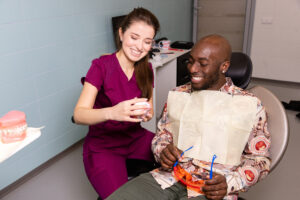Your child’s teeth usually start coming in when they’re about six months old, but it’s not uncommon for it to happen later or even earlier. But when it does happen, you’ll know.
As the teeth begin to erupt, your baby may become a bit, well, crankier than usual. This means crying, a refusal to eat or drink, and plenty of drool, which can sometimes lead to rashes around the mouth or chin. You may even notice them chewing on solid objects more than usual as they test out their new teeth. While this is all part of the natural process of growing those first little chompers, there are a few things you can do to make it easier on the tyke, and by extension, your frazzled nerves.
Cool It Down
Cold is great for reducing swelling and irritation, and can help address the pain that comes with teething. If your child has a teething ring, you can pop it in the fridge for ten to fifteen minutes to cool it down before handing it over. A cold washcloth will also work well. Just be sure not to freeze the object you’re using. If the temperature is too cold, the child won’t want to hold it, which will defeat the purpose.
A Mother’s (or Father’s) Touch
Gently rubbing their gums with a clean finger or a small sterile gauze pad can work wonders, and has been used to calm cantankerous kiddies since the dawn of time. The pressure will soothe the sore gums, and the interaction will often distract your child from crying. A finger, knuckle or even the side of your hand can all do the trick. Just be sure that anything you put in your child’s mouth is safe and poses no risk of choking. Trim and clean your nails, remove rings, thoroughly scrub your hands, and ensure that any gauze used is fresh from a sealed package and discarded after a single use.
Clean ’Em Up
Leaving drool around the mouth or chin can lead to irritation and rashes — and in some cases, infection. Use a clean, soft cloth to regularly dab away excess moisture as your baby teethes. If irritation or a rash does begin to develop, use a moisturizing lotion specially formulated for your baby’s soft skin and safe for use near their mouth.
The Shift to Solid Foods
Be sure to check with your pediatrician/family physician first, but munchies with more consistency can provide soothing pressure. Try chilled fruits and veggies like bananas, cucumbers and carrots to give the little guy or girl some practise gnawing. They’ll love trying out the new teeth, and it may offer them a bit of relief. Of course, you should be sure that your child is ready to eat solid foods and always supervise them while they eat so they don’t choke — remember, they’re new at this.
Teething Help from Your Dentist
If the tricks we mentioned aren’t cutting it, you can try using over-the-counter pain medications formulated for babies like acetaminophen (Tylenol) or ibuprofen (Motrin). Again, be sure to check with your pediatrician/family physician first. There are also a number of teething gels available. Please ensure the gel is sugar-free. And if the teething is particularly troublesome, give us a call. We’ll help you out.








